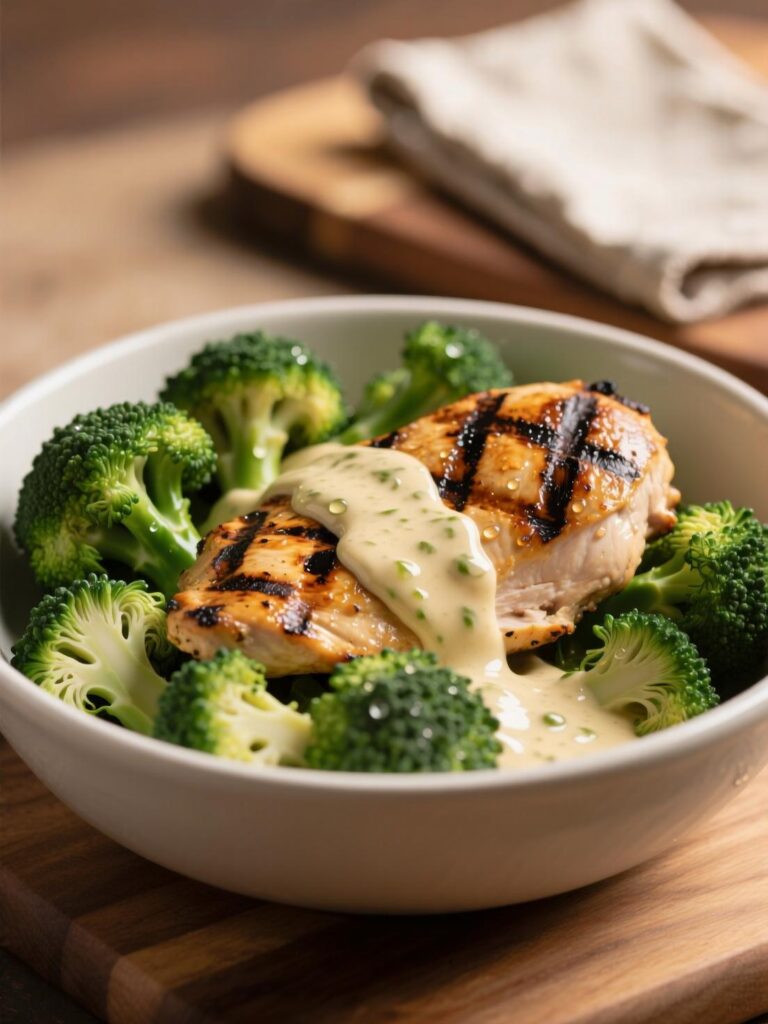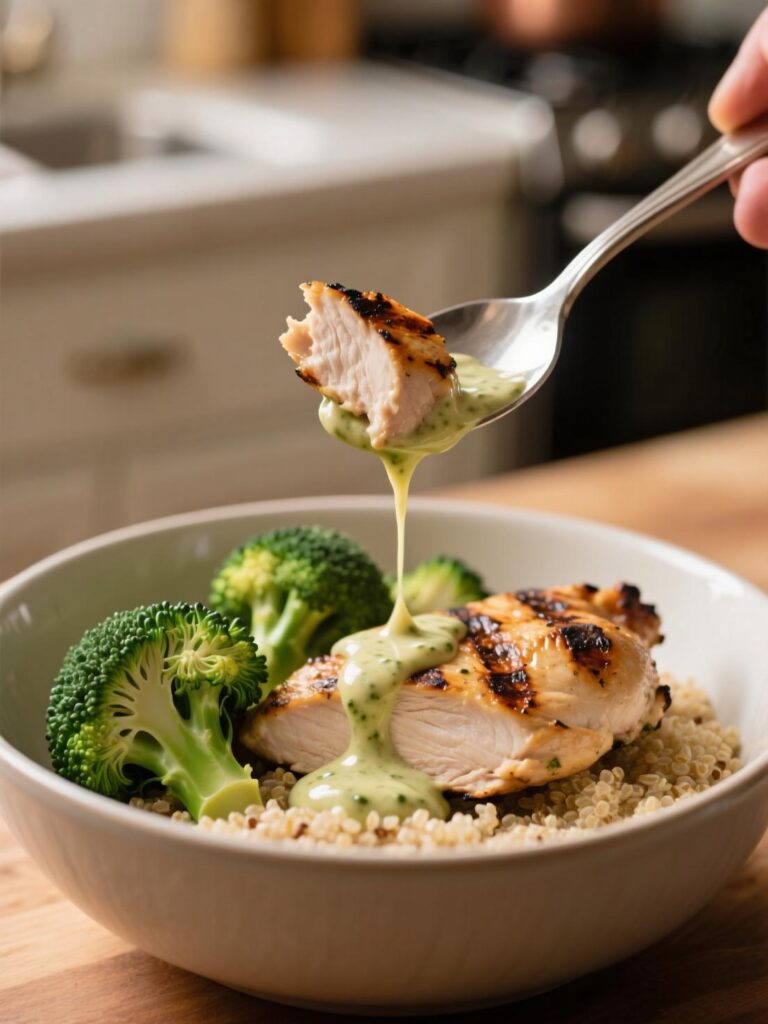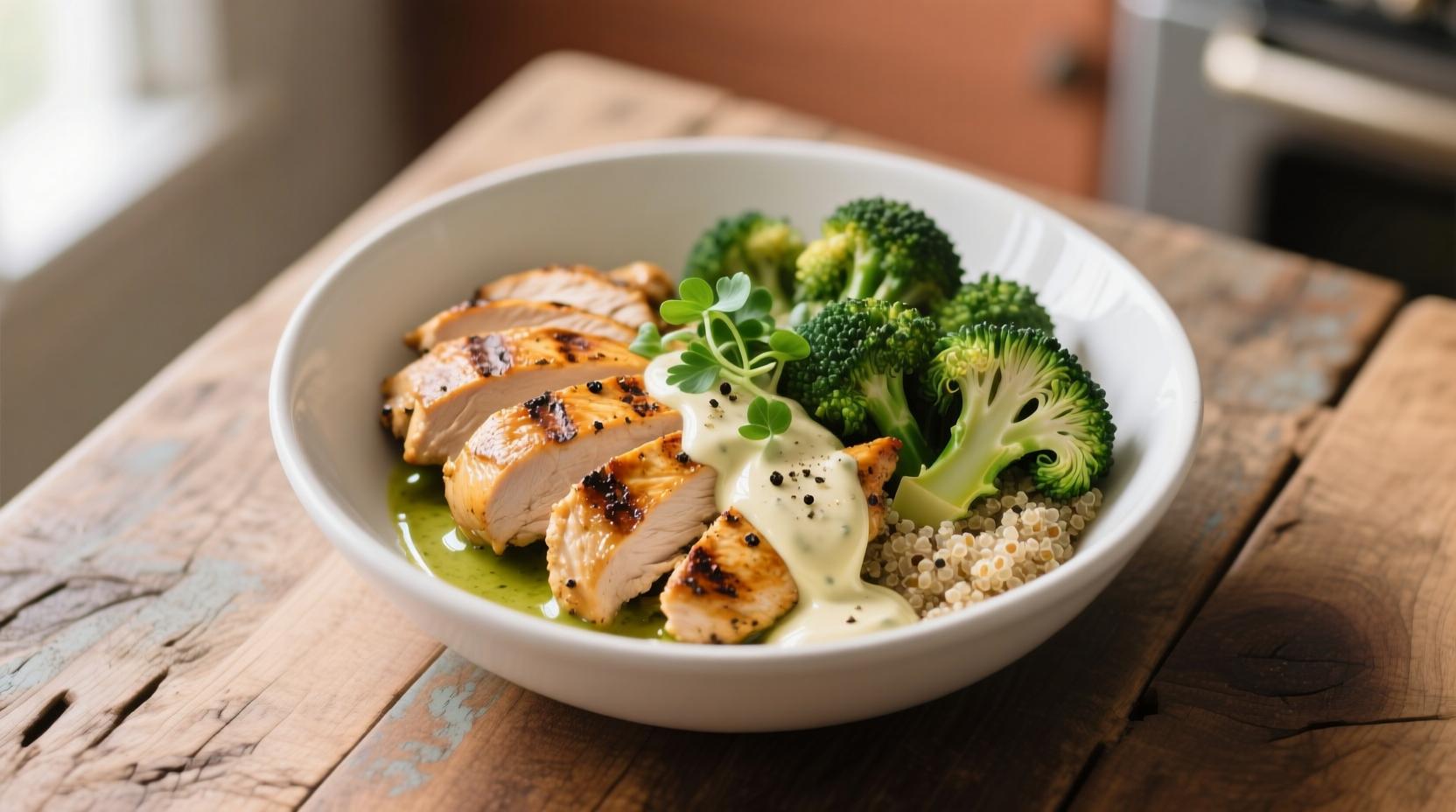If grilled chicken could talk, it would probably brag about this dish. It’s not just another “healthy” bowl. This is the kind of meal that sneaks into your weekly routine and refuses to leave. The chicken? Juicy with a hint of char. The broccoli? Tender but with bite. And the creamy garlic sauce? It clings to everything like it knows it’s the star.
I’m not here to sell you on yet another boring chicken and vegetable combo. This is a carefully balanced build of flavor, texture, and nutrition. Chefs in pro kitchens already know—the secret to dishes like this lies in technique, not just the ingredient list.
Why This Bowl Works So Well
Grilled chicken and broccoli sounds simple, right? But simple food exposes flaws. If the chicken is overcooked, you notice immediately. If the broccoli is soggy, the whole bowl feels flat. Professionals work with precise control over heat, seasoning, and timing to avoid those traps.
The creamy garlic sauce isn’t just an afterthought. It’s the binder between protein and veg, giving the dish a richness without drowning it in grease. When you balance the acidity, salt, and creaminess correctly, you create something that’s both indulgent and light enough to keep eating.
In restaurant kitchens, we often talk about balance points. You need contrast: the smoky char from the grill, the snap of fresh broccoli, the lush creaminess of the sauce. That’s what keeps a diner going back for another forkful.
Choosing the Right Chicken Cut
Chefs will debate this over staff meals. Some swear by boneless, skinless chicken breasts for their lean profile. Others say thighs are the only way to get full, juicy flavor.
From a culinary perspective, thighs win in texture and moisture retention. They handle high-heat grilling without drying out. Breasts, while cleaner in taste, demand more attention to avoid overcooking. If you’re going for presentation and a neater bowl, breasts can be sliced thinly after resting.
Pro tip—always buy chicken that’s air-chilled rather than water-chilled. It grills better because it hasn’t soaked up extra water, which can steam rather than sear the meat.

The Broccoli Factor – Texture is King
Anyone who’s worked in a fine dining kitchen knows broccoli is unforgiving. Overcook it and you’ve lost the fight before you plate. Under-season it and it feels like an afterthought.
Blanching before grilling is a pro move. It locks in that vivid green and par-cooks the stems so you can just kiss them on the grill without burning. A quick toss in olive oil, salt, and a touch of lemon zest makes them pop in flavor without adding heavy calories.
One mistake I see home cooks make is crowding broccoli on the grill. The steam builds, and instead of char marks you get sad, limp florets. Spread them out and give them space to breathe.
Building the Creamy Garlic Sauce Like a Pro
This sauce is the soul of the bowl. Garlic isn’t shy here—it’s bold but softened by creaminess. The trick? Roast the garlic instead of just sautéing. Roasting mellows its bite and adds sweetness, so you can use more without overwhelming the dish.
A good creamy garlic sauce has layers. Start with roasted garlic puree, add Greek yogurt for tang, a little mayo for body, and a splash of fresh lemon juice for brightness. Season carefully; a sauce without enough salt will make the whole bowl taste flat.
Professionals will often mount the sauce with a touch of olive oil at the end, whisking until it emulsifies. That little step adds silkiness you can’t get from dairy alone.
The Grill – Direct vs. Indirect Heat
There’s an art to grilling chicken right. Professionals don’t just throw it over a screaming hot flame and hope for the best. They start with a sear over direct heat for those gorgeous marks, then shift to indirect heat to finish cooking gently.
For thighs, you want about 165°F internal temp for best texture. For breasts, 160°F is enough, letting carryover cooking finish the job. Always rest the meat—yes, even in a bowl format—because juices need a moment to redistribute.
Broccoli works best over medium-high heat, flipping every minute or so until charred edges appear. The smoke from the chicken will subtly flavor the broccoli too, which is exactly what you want.
Layering for Flavor – Not Just Pretty Plating
Professional chefs think about “flavor layering” before they even start cooking. Here, it means seasoning each component separately before bringing them together. The chicken gets a dry rub with smoked paprika, garlic powder, and black pepper. The broccoli gets olive oil, lemon, and flaky sea salt. The sauce is seasoned on its own.
When you build the bowl, don’t just pile everything on top of rice or grains. Spread the grains, place the broccoli in one section, slice the chicken and fan it out, then spoon the sauce strategically so it seeps into both protein and veg. This isn’t just aesthetics—it makes sure every bite tastes balanced.
Grain Base or No Grain at All?
In restaurants, we’d often default to jasmine rice or quinoa for bowls like this, but there’s no rule. Cauliflower rice keeps it low-carb without sacrificing texture. Farro adds chew and a nutty background.
Interestingly, adding a warm grain base under grilled chicken helps retain heat in the dish. That’s why, in pro service, the bowls don’t arrive cold even if they’ve been sitting a minute in the pass.
Nutritional Perspective – This is Balanced Fuel
From a dietitian’s standpoint, this dish is gold. Lean protein from chicken, high-fiber broccoli, and healthy fats from olive oil. The creamy sauce, if made with Greek yogurt, offers probiotics and protein without overloading saturated fat.
According to USDA data, a typical serving of grilled chicken breast (3 oz) has about 26g of protein. Combine that with the vitamins in broccoli—vitamin C, K, and folate—and you’ve got a nutrient-dense meal that doesn’t feel like a chore to eat.
Common Mistakes Even Experienced Cooks Make
One is over-marinating chicken. Acid in a marinade can “cook” the outside, creating a tough texture before you even hit the grill. Two to three hours is plenty for flavor absorption.
Another is forgetting to dry the chicken before grilling. Moisture on the surface prevents a good sear. A quick pat with paper towels makes all the difference.
And here’s a subtle one—saucing too early. If you drown the chicken in garlic sauce while it’s still hot, the sauce thins out and slides off. Always sauce right before serving.

Trends & Variations in Pro Kitchens
Across modern kitchens, grilled chicken bowls are trending toward global influences. Swap the creamy garlic sauce for a tahini-lemon blend and you’ve got Mediterranean flair. Add gochujang to the marinade and the dish heads toward Korean-inspired spice.
Some chefs are experimenting with grilling broccoli rabe or broccolini instead of standard broccoli for a more bitter, complex profile. Others are smoking the chicken first, then finishing it on a high-heat grill for layers of flavor.
A Chef’s Quick Blueprint for This Bowl
- Air-chilled chicken thighs, seasoned with paprika, garlic powder, salt, and pepper
- Broccoli florets blanched, tossed in olive oil and lemon zest
- Roasted garlic sauce with yogurt, mayo, lemon juice, and olive oil
- Jasmine rice base, warm and lightly salted
- Assemble with intentional layering, sauce added last, garnish with parsley or microgreens
Final Thoughts
Grilled chicken and broccoli bowls can be basic—or they can be crave-worthy. The difference lies in how you treat each component. Control heat, season with intent, respect textures, and you’ll turn a “weekday dinner” into something worth repeating.
For professional cooks, this is a dish that works on menus because it’s adaptable, nutritionally balanced, and can be scaled easily without losing integrity. For home cooks, it’s a blueprint for understanding how little details—drying chicken, blanching broccoli, roasting garlic—can elevate something simple into something remarkable.
If you nail this once, you’ll never go back to soggy broccoli or dry chicken again. And the garlic sauce? Well, that’s probably going to find its way onto everything else you cook.
FAQs
How do I keep grilled chicken juicy for the bowl?
Use indirect heat after searing and let it rest before slicing.
Should I use chicken thighs or breasts?
Thighs stay juicier, but breasts work if cooked carefully.
How do I stop broccoli from going soggy on the grill?
Blanch first, then grill over medium-high heat without crowding.
Can I make the creamy garlic sauce ahead of time?
Yes, store in the fridge for up to 3 days and stir before serving.
What’s the best grain base for this bowl?
Jasmine rice, quinoa, or farro all work depending on your texture preference.
How long should I marinate the chicken?
Two to three hours is enough for flavor without toughening the meat.
Can I make this recipe dairy-free?
Yes, swap Greek yogurt for dairy-free yogurt in the sauce.
How do I get the char marks without burning the food?
Start over high heat for marks, then move to medium heat to finish.
Is this meal good for meal prep?
Yes, keep sauce separate until serving to maintain texture.
Can I use broccolini instead of broccoli?
Absolutely, it adds a slightly more bitter, complex flavor.

Mariana is a passionate home cook who creates delicious, easy-to-follow recipes for busy people. From energizing breakfasts to satisfying dinners and indulgent desserts, her dishes are designed to fuel both your body and hustle.
When she’s not in the kitchen, she’s exploring new flavors and dreaming up her next recipe to share with the Foodie Hustle community.

